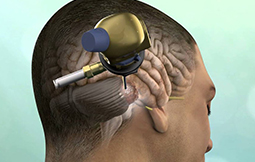
Skull base surgery is a highly specialized, minimally invasive surgical technique that is performed to eliminate cancerous or benign growth and brain abnormalities located on the underside of the brain. The surgery is done at the base of the skull and at the top of the first few vertebrae on the spinal cord.
Skull base surgery is a highly specialized, minimally invasive surgical technique that is performed to eliminate cancerous or benign growth and brain abnormalities located on the underside of the brain. The surgery is done at the base of the skull and at the top of the first few vertebrae on the spinal cord. During the surgery, surgeons use special instruments inserted through the skull’s natural openings (e.g., nose, mouth, and above the eyes) to operate rather than accessing the brain through a craniotomy (surgical opening of the skull). Your surgeon will advise the best type of surgery depending on the symptoms, the type of growth, and the location of the surgery.
A skull base surgery is recommended to the patients suffering from the following medical ailments:
Before undergoing a skull base surgery, there are certain medical tests and exams that play a crucial role in the prognosis of cranial base surgery as it cannot be examined with the naked eye. Usually, your doctor will recommend the following tests before planning your surgery:
Skull base surgery is major surgery, the first step of the surgery is giving the patient general anesthesia for about 24 hours. The patient is kept on a heating blanket that is positioned over an alternating pressure air mattress for additional comfort. When the petrous carotid, the main blood vessel is dissected, the patient’s blood pressure is purposely kept abnormally low. As many patients experienced bleeding during surgery, doctors today start fresh frozen plasma and platelet infusions once the patient has gone through 4 units of blood. This method has now become a procedure and has proved to prevent the potentially fatal intracranial bleeding during and post the surgery.
Post skull cancer spine surgery, the patient has moved the ICU and kept under observation. During this stage, the doctors take care of the patient as the patient’s respiratory parameters need to be adequate and the patient should be able to maintain his blood oxygen saturation while being intubated and spontaneously breathing. Usually, the patients can go home after 7 to 10 days, once all their reports are fine. However, It might take a few months to get completely after this kind of surgery, and therefore, patients are recommended to take good care of themselves and avoid heavy activities.
After skull base surgery, you will be closely cared for by your medical team as skull base surgery is a highly complicated procedure and thus, brings with it a large number of risks and complications for the patient. You will be told about all the risks associated with the surgery beforehand so that you can make a well-informed decision. Some commonly known risks include:
Copyright © 2025 IMA | All Rights Reserved.